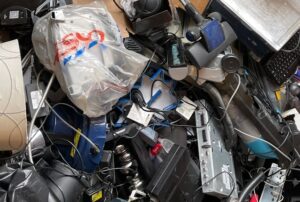Physical Address
23,24,25 & 26, 2nd Floor, Software Technology Park India, Opp: Garware Stadium,MIDC, Chikalthana, Aurangabad, Maharashtra – 431001 India
Physical Address
23,24,25 & 26, 2nd Floor, Software Technology Park India, Opp: Garware Stadium,MIDC, Chikalthana, Aurangabad, Maharashtra – 431001 India

As Sri Lanka’s digital economy grows, so does a looming environmental crisis: electronic waste, or e-waste. On International E-Waste Day, observed on October 14, we spotlight this rapidly expanding issue and explore how the improper disposal of electronic devices threatens public health and the environment. Sri Lanka, like many countries, must act swiftly to manage its e-waste before it spirals out of control.
The Rising Tide of E-Waste in Sri Lanka
Sri Lanka’s increasing dependence on smartphones, tablets, home appliances, and other electronic equipment is a testament to the country’s digital evolution. However, with shorter product lifecycles and limited repair options, obsolete devices are being discarded faster than ever. This flood of electronic devices contributes to Sri Lanka’s growing e-waste problem.
Globally, 62 million metric tons of e-waste were generated in 2022, with forecasts projecting a further increase to 82 million metric tons by 2030. Unfortunately, recycling is not keeping pace—only 22.3% of e-waste is formally collected and recycled. Sri Lanka mirrors this global challenge, with large portions of its e-waste ending up in informal recycling sectors or landfills, exposing workers and nearby communities to hazardous materials like lead, mercury, and cadmium.
Global e-waste is projected to soar to 74.7 million tonnes by 2030, posing significant environmental and health challenges. Image by; Image: UNU, ITU and ISWA
Environmental and Health Risks
The International Labor Organization (ILO) and WHO estimate that millions of women and child laborers working in the informal recycling sector globally may be at risk of hazardous e-waste exposures. Lead is a common substance released into the environment when e-waste is recycled, stored or dumped using informal activities, including open burning. Read here
The dangers of e-waste extend far beyond the visual clutter of discarded gadgets. Toxic substances within electronic waste leach into the soil and water systems, contaminating local ecosystems. Workers in informal recycling hubs, often without protective equipment, risk exposure to dangerous chemicals that can cause respiratory issues, neurological disorders, and even cancer. Furthermore, Sri Lanka’s existing waste management infrastructure is struggling to handle the influx of discarded electronics, creating a pressing need for better systems. Read here
Efforts to Address the Crisis
Recognizing the urgent need for action, the Central Environmental Authority (CEA) of Sri Lanka has launched several initiatives to address e-waste. These include island-wide drop-off events, mobile collection services, and partnerships with companies to promote safe disposal practices. However, most collected devices are disassembled, with only the valuable components reused. The hazardous parts are often stored indefinitely, awaiting proper disposal facilities, which remain scarce.
The CEA has proposed stricter measures, including the return of e-waste to manufacturing countries once products reach the end of their lifecycle. However, the implementation of these regulations has been slow, and Sri Lanka’s small land area complicates plans for centralized landfill sites dedicated to hazardous waste.
How Individuals Can Help
Addressing the e-waste crisis requires a collective effort from governments, businesses, and individuals. Here are some practical ways consumers can contribute to managing e-waste responsibly:
Read here to identify 7 ways to boost e-waste recycling
The Role of Public Participation and Policy Reform
The global experience underscores the importance of policy frameworks to manage e-waste effectively. Countries with Extended Producer Responsibility (EPR) programs have seen better recycling rates by holding manufacturers accountable for the disposal of electronic goods. Sri Lanka’s policymakers could strengthen such regulations and align with the Basel Convention on the Transboundary Movement of Hazardous Waste to reduce illegal shipments of e-waste and improve environmental safeguards.
Conclusion
On this International E-Waste Day 2024, Sri Lanka stands at a critical juncture. The rising tide of discarded electronics threatens to overwhelm waste management systems and harm the environment. However, with increased awareness, enhanced policy measures, and stronger public participation, the country can turn this challenge into an opportunity to foster sustainable practices.
While Sri Lanka has taken important first steps, there is a long road ahead to build a circular economy where discarded electronics are viewed as valuable resources rather than waste. As individuals and communities come together to tackle this issue, the future can be one where electronic devices enhance lives without compromising the health of the planet.
Let this year’s International E-Waste Day be a call to action for everyone—because every device discarded responsibly brings us closer to a cleaner and safer future.
References:
https://www.basel.int/default.aspx
https://www.who.int/news-room/fact-sheets/detail/electronic-waste-%28e-waste%29
https://www.weforum.org/agenda/2024/04/e-waste-recycling-electronics-appliances
Images/ Video:
Banner Image: Photo by John Cameron on Unsplash